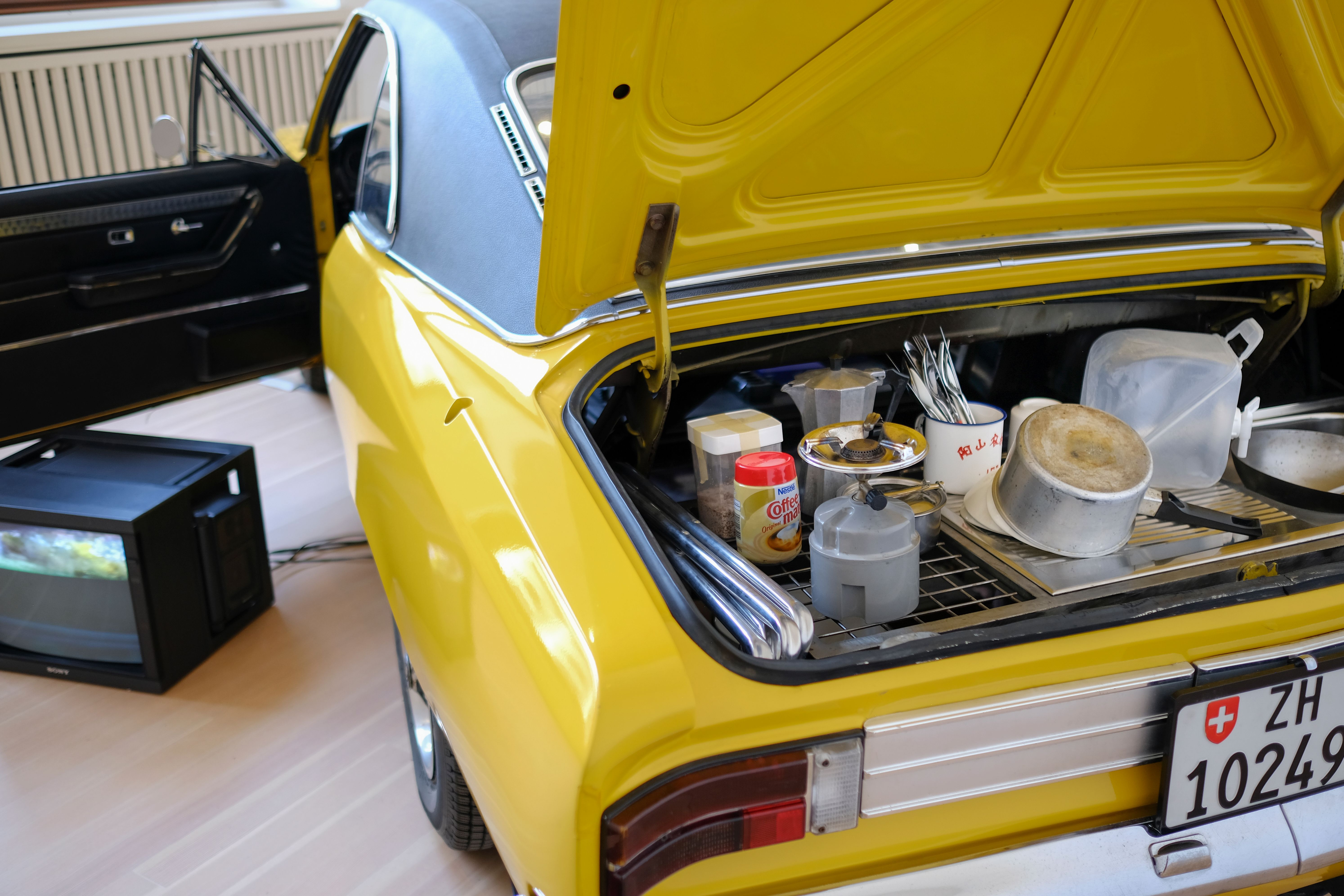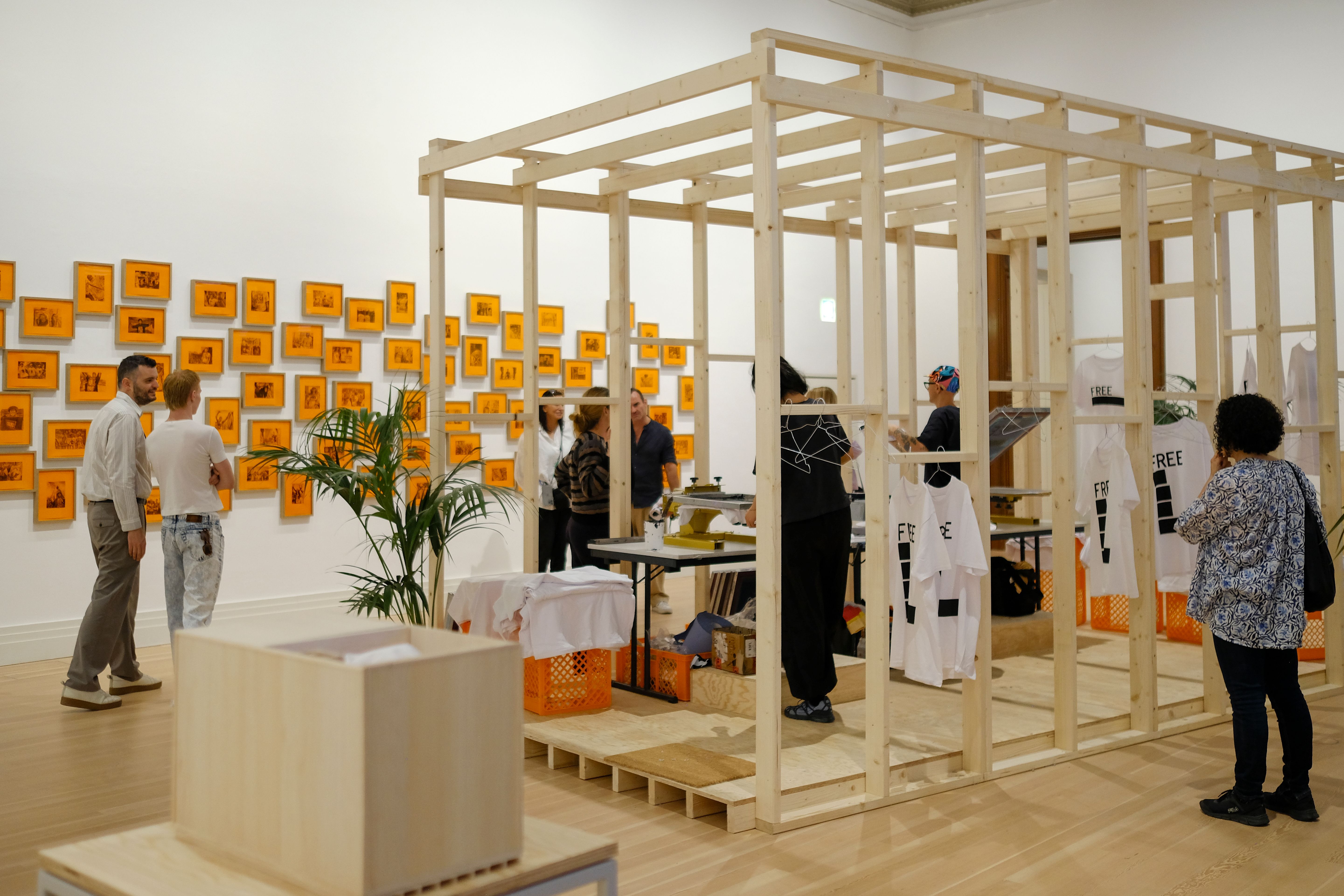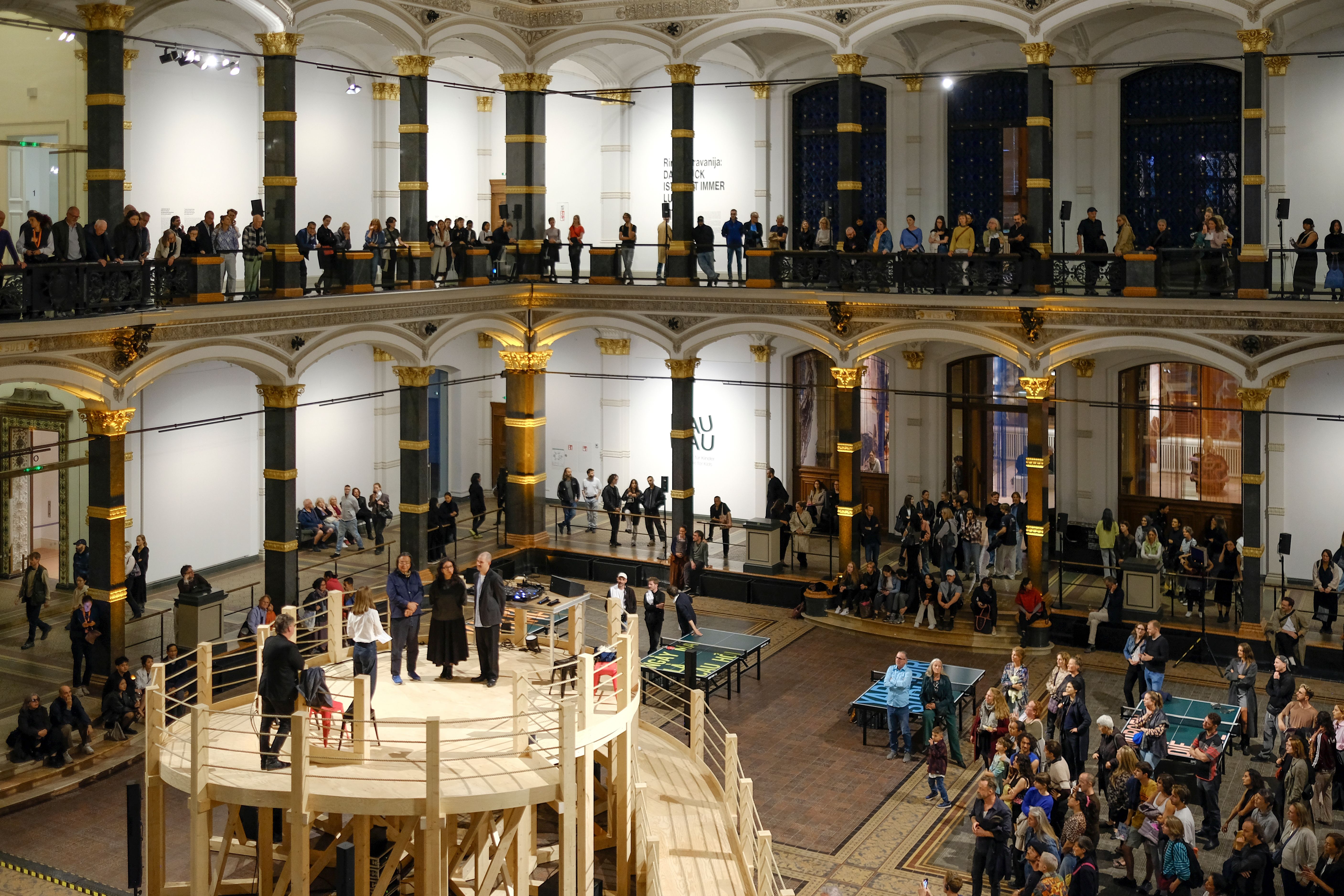Shows
Rirkrit Tiravanija’s “DAS GLÜCK IST NICHT IMMER LUSTIG”

Rirkrit Tiravanija
DAS GLÜCK IST NICHT IMMER LUSTIG (Happiness is not always fun)
Gropius Bau
Berlin
Sep 12–Jan 12, 2025
There is something both thrilling and deflating about seeing historically significant or socially engaged artworks exhibited in a museum long after they have entered the art landscape. An overview of more than three decades of Argentinian-born Thai artist Rirkrit Tiravanija’s practice presented such an experience, highlighting projects that speak to the cultural and political context of Germany, where he partly lives. Its title, “DAS GLÜCK IST NICHT IMMER LUSTIG (Happiness is not always fun),” borrows a line from Rainer Werner Fassbinder’s 1974 film Ali: Fear Eats the Soul—which explores the prejudice faced by a Moroccan migrant worker in Germany—thereby framing how audiences might have approached the myriad tensions threaded throughout the exhibition.
The stately halls of Gropius Bau showcased over 80 works, many dating back to the 1980s and ’90s. Of particular resonance here was untitled 1991 (tom ka soup) (1991), an offering of hot tom kha (Thai coconut soup) for lunchtime visitors and gallery workers at the entrance. This gesture formed part of a project, by now replayed in countless variations worldwide, where Tiravanija, or one of his students, or a paid worker, prepare and serve Thai food as art, creating pockets of messy, unpredictable sociality in otherwise static gallery settings. In another room untitled 1989 ( ) (1989/2004/2024) comprised an electric hotplate and pot on a plinth, surrounded by coconut milk cans, a bottle of fish sauce, and additional ingredients for making yellow curry. With framed photos of a similar post-/pre-cooking scene, untitled 1990 (for documentation only, fading polaroid) 1–3 (1990), in the background, the effect was one of coming too late to a party and having missed the action, or viewing a three-dimensional catalog. In the wall text, Tiravanija explained how Western institutions typically (mis)represent cultural objects (Buddha statues, vessels, even food traditions), dislocating them from their original meaning: “When I see Buddha, I see something else, and what I see is missing in the museum display.” His response was simply and radically to “take the pot out of the case . . . and cook in it,” reinstating context and conviviality.

Installation view of RIRKRIT TIRAVANIJA’s untitled 2022 (chance will never abolish), 2022, multimedia installation, dimensions variable, at Gropius Bau, Berlin, 2024. Photo by Guannan Li. Courtesy Gropius Bau.
In some of his early works, this shift in use and visibility accompanied other forms of institutional critique. Untitled 1994 (der stand der dinge) (1994/2024) revisited a show at Kölnischer Kunstverein in Cologne, for which Tiravanija moved objects from the museum storeroom to its gallery space, alongside the registrar’s entire office. Here in Berlin, a room lined with framed exhibition posters and furnished with such items as a tall indoor plant, a pinboard with a sketched exhibition floorplan, and a replica plate of noodles on a filing cabinet—apparently the relocated offices of Gropius Bau’s director and team—felt more cute than critical.
A quieter work was untitled 1987 (text in red and black) (1987/2024). It was originally shown at the Art Institute of Chicago during Tiravanija’s studies there in the late 1980s, and in Berlin it was restaged in the grand Schliemann-Saal. What could have been mistaken for an empty wall bore a tiny line of lettering politely if obliquely demanding that the Institute return “our cultural artifacts . . . otherwise we will blow it up,” extending prior works in which Tiravanija questioned the provenance of Thai artifacts in the museum’s collection. In this room where Ottoman treasures smuggled from the ancient ruins of Hisarlik to Berlin were displayed in the 1920s and ’30s, its clarion call expanded outward to encompass wider discourse around the repatriation of ethnographic materials.

Installation view of RIRKRIT TIRAVANIJA’s untitled 2024 (demo station no. 8)), 2024, interactive installation, dimensions variable, at Gropius Bau, Berlin, 2024. Photo by Guannan Li. Courtesy Gropius Bau.
Elsewhere, the exhibition encouraged guests to interact in other unorthodox ways: to rehearse or perform in a fully-equipped recording studio, rest on discretely placed bedding mats, drink Chinese tea inside a tent made of monks’ robes, or make calls from retro wall-mounted telephones to other rooms in the building. On a spiral wooden stage in the central atrium, untitled 2024 (demo station no. 8) (2024), groups and individuals hosted their own open “demonstrations,” presentations, or talks. Participants strained valiantly to hear above the patter from untitled 2024 (tomorrow is the question) (2024), a sea of free ping pong tables surrounding the structure that were in constant use.
Untitled 1993 (café Deutschland) (1993) is a makeshift cafe that was first installed at Cologne’s Galerie Max Hetzler according to faxed instructions from Tiravanija, who could not make his first trip to Germany due to visa problems. Reacting to the recent deadly racist attack on Turkish communities in Mölln, here it encouraged visitors to engage in productive conversations with one another around critical social issues. That such activity is now relatively unremarkable within a major institution shows how social interventions like Tiravanija’s have permeated standard museum practice. As with previous stagings, the new installation included a wall of exhibition catalogs from its host and a city view through the window. In today’s Berlin, unsettled by sweeping anti-immigration sentiment, art-funding cuts, and sociopolitical polarization, chatting with a stranger while overlooking the Senate (where numerous political demonstrations have lately gathered) remained a useful way to “take the pot out of the case” and confront what we might otherwise avoid.
Tessa Zettel is a multidisciplinary artist, writer, and researcher based in Gadigal Country/Sydney.







